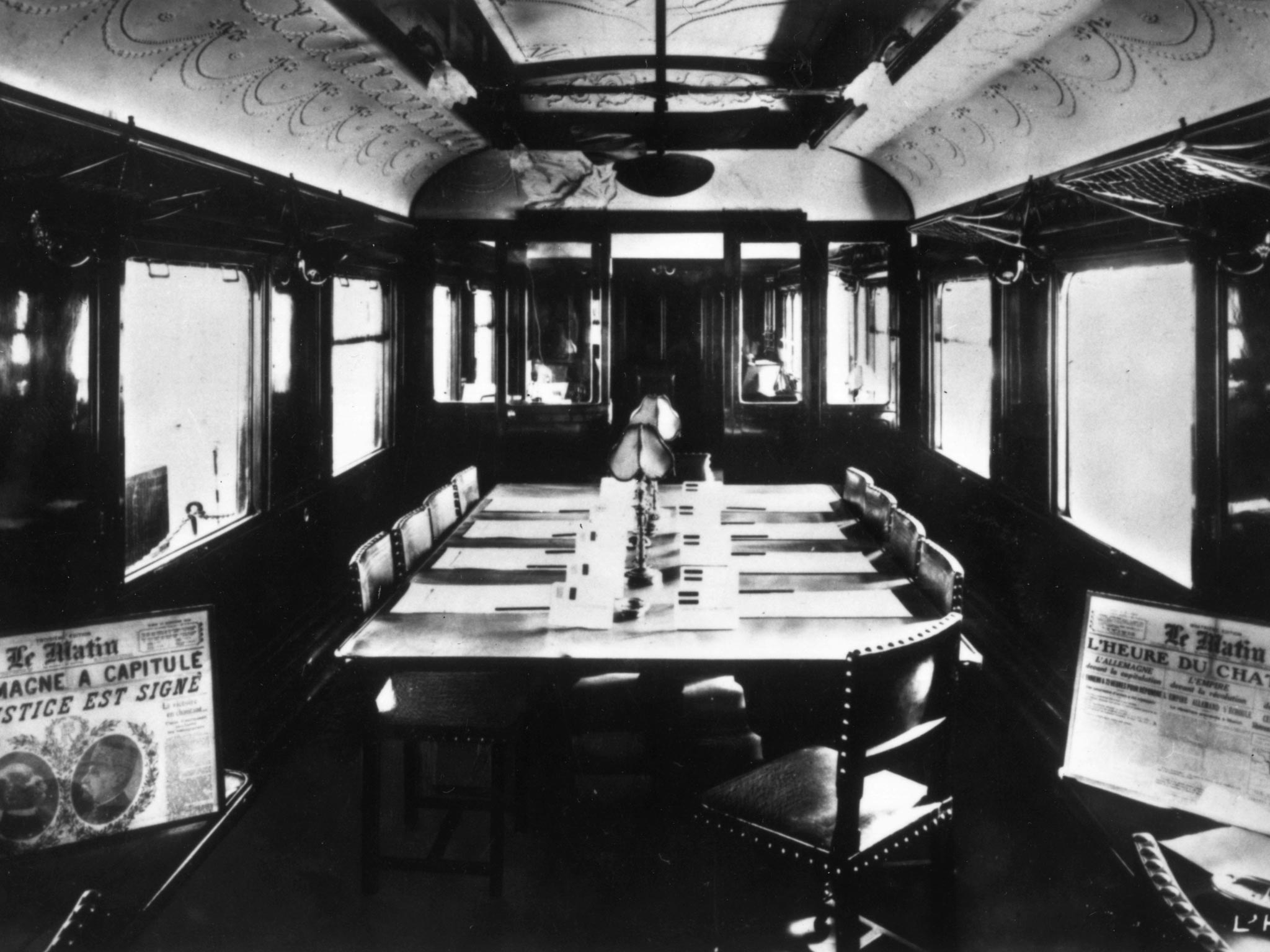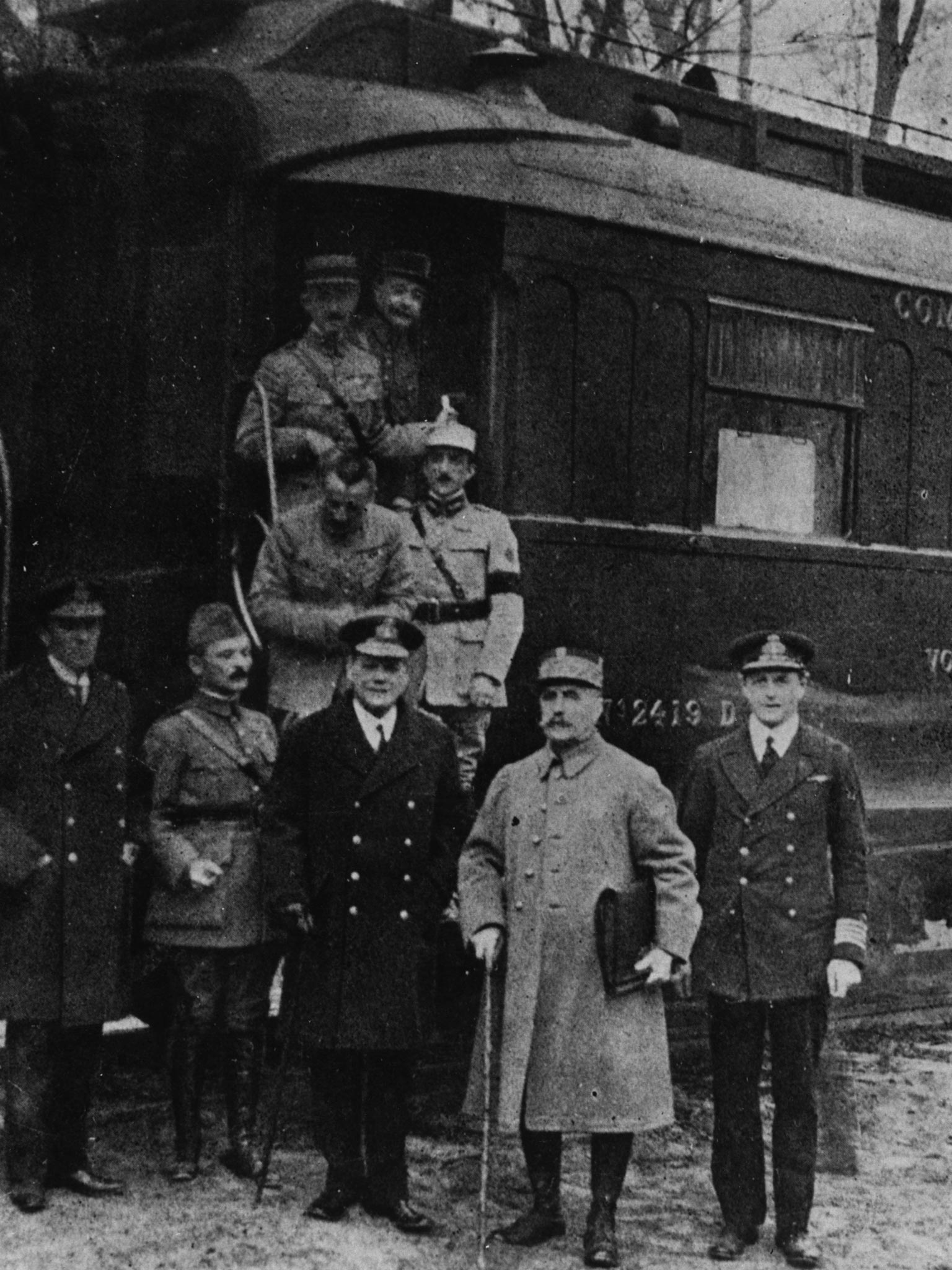A History of the First World War in 100 Moments: Peace without magnanimity - the summit in a railway siding that ended the fighting
John Lichfield on the strange meeting in the forest of Compiègne that culminated in the signing of the Armistice

On 8 November 1918, two trains came to a halt in adjoining sidings at Rethondes in the forest of Compiègne, 40 miles north of Paris.
One, formerly the imperial train of Emperor Napoleon III, contained German civilian politicians and obscure, senior military officers. They were untidy and exhausted after travelling overnight, in the greatest secrecy, through the front lines in northern France.
The other train was the permanent home of the commander-in-chief of the allied armies, Marshal Ferdinand Foch. His guests included the British First Lord of the Admiralty, Sir Rosslyn Wemyss.
The German delegation, led by Matthias Erzberger, a moderate politician, shambled across the 100 metres to Foch’s dark-blue wagon-lit.
The marshal leaned across to his interpreter and said: “Ask these gentlemen what they want.”
Erzberger said that he had come to hear armistice proposals from the Allies. Foch replied: “I have no proposals to make.”
Count Alfred von Oberndorff, from the German foreign ministry, said in French that his delegation was there to seek “the conditions for the Armistice”. Foch replied: “I have no conditions to offer.”
The German delegation rapidly grasped the situation. After four years and three months of the most terrible war yet known to man, there were to be no negotiations. The Germans were to grovel. They were to be humiliated. They were to ask for an armistice. The terms would be dictated by the Allies.
And so they were. But it still took another three days – and many thousands of deaths as the fighting raged on – before the Armistice was signed.
Compiègne was the end but it was also, miserably, the beginning. The seeds for another war were sown in those three days. Adolf Hitler, a great man for symbolism, made the French sign an equally humiliating armistice after their defeat in June 1940 at the same place and in the same carriage, Compagnie Internationale des Wagons-Lits No 2419.
Hitler had a point. There are at least two direct links between the two events. The fact that the 1918 Armistice was signed by moderate German politicians and obscure generals fed the myth of the “stab in the back” – the great Nazi-fostered lie that political treachery, not defeat in the field, had forced Germany’s capitulation.
In November 1918, the German high command knew that their army was close to collapse after three months of defeats. Germany was a virtual military dictatorship but close to ungovernable by this time. Civilians were starving after four years of war and naval blockade. Big cities, like Berlin and Munich, were on the brink of revolution.
The German commander, Paul von Hindenburg, simultaneously urged the Armistice and cunningly distanced himself from it by appearing to hand over power to peace-minded civilians (a key demand of the US President, Woodrow Wilson).
Meanwhile, Foch’s attitude in the Compiègne forest presaged France’s uncompromising approach at the Versailles peace conference which formally ended the war the following year. All the Versailles terms which humiliated and infuriated Germany – punitive reparations, the occupation of the Rhineland by Allied troops – were among the points dictated in wagon No 2419.

The fact that the war ended on a train is no mere anecdotal detail: it is a piece of profoundly fitting symbolism. This had been the first great industrial war – or maybe the second after the American Civil War. Railways had played a crucial role in supplying the machinery of war with soldiers in their millions. They provided the means to feed troops in undreamed-of numbers; and also the means to destroy them. Temporary branch lines and sidings were constructed to within a mile of the British front on the Somme.
The sidings in the Compiègne forest where the armistice was signed were also a wartime construction, built originally to house an enormous, French rail-mounted gun. The site was chosen by Foch for its remoteness. He wanted to avoid news leaking of a possible armistice. He feared that he would be blamed for extending the war if the negotiations failed.
In the event, the German delegation received orders from Berlin to accept whatever terms they were offered.
On Saturday 9 November, the Kaiser abdicated. On the evening of the 10th, the Germans in the Rethondes siding received messages both from the civilian government and from Hindenburg telling them to sign.
After a few final quibbles – the Allies were asking the Germans to surrender more submarines and locomotives than they actually possessed – the document was signed at 5.12am on 11 November.
Foch refused to shake hands. He said: “Eh bien, messieurs, c’est fini. Allez.” (“Well, gentlemen, it’s finished. Go.”)
But it wasn’t quite finished. For the sake of tidiness, the ceasefire was to take effect at 11am – the 11th hour of the 11th day of the 11th month. It is estimated that 2,738 men on all sides died in those final, tidy, six hours of fighting.
Tomorrow: Peace at last
The '100 Moments' already published can be seen at: independent.co.uk/greatwar
Join our commenting forum
Join thought-provoking conversations, follow other Independent readers and see their replies
0Comments